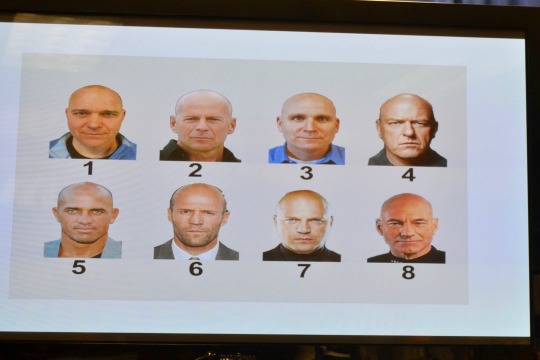In a recent series of grocery store holdups, detectives had their suspect: a six-foot-tall, 160-pound man with a shaved head who bore a striking resemblance to Chester County District Attorney Tom Hogan.

In fact, Hogan’s image appeared in a photo lineup prominently displayed during a press conference on Tuesday, April 12, at the Chester County District Attorney’s Office. But Hogan was masquerading as a mugger to underscore the importance of statewide uniformity in eyewitness identification procedures.
Hogan, chairman of the Best Practices Committee for the Pennsylvania District Attorneys Association (PDAA), was joined by Montgomery County District Attorney Kevin Steele, Berks County District Attorney John T. Adams, and a half-dozen other law-enforcement officials to announce guidelines that would be incorporated into law enforcement training throughout the state. A simultaneous announcement occurred in Harrisburg by other PDAA representatives, Hogan said.
He explained that the announcement marked the first time in its history that the PDAA has made a statewide best practices recommendation. He likened the new research and technologies to the field of medicine, suggesting that if a doctor developed a cure for cancer, the public would want that information shared.
Witness identification was the first agenda item because “it’s a hot topic,” Hogan said, noting that many cases hinge on it.
Among Pennsylvania’s 67 counties are 1,117 law-enforcement agencies – “more police departments than any state in the U.S.,” Hogan said. “Prosecutors want to convict the guilty, protect the innocent, and stand up for the rights of victims,” he said. “It’s important that we get this protocol right across the state.”
Toward that end, he said PDAA received input from law-enforcement, social scientists, criminal-defense agencies and academics to formulate the best way to conduct a fair and reliable eyewitness ID procedure. The PDAA was formed in 2014 to serve as a collaborative network to identify best practices, research, and legal methods.
Among the recommendations: presenting photo lineups simultaneously rather than sequentially. New research shows that witnesses benefit from being able to compare and contrast, Hogan said.
In addition, an officer not involved in the case should administer the photo lineup, using neutral language to avoid bias. Someone connected to the prosecution could subconsciously affect the outcome. “If I’m there, I’m rooting for them to pick the right person,” Hogan said.
Finally, the protocols call for extensive record-keeping, such as documenting the witness’s demeanor and response time, and preserving the evidence, including all of the photographs used.
Hogan said that the guidelines represent recommendations and that their implementation would be determined by each district attorney. Hogan, Steele and Adams all said that they are already using some of them and that the initial reaction from the law-enforcement community has been positive.
Steele said the committee would now turn its focus to three other emerging issues: body cameras , officer-involved shootings, and the recording of interrogations. He said the group would also be seeking legislative fixes for the state’s Wiretap Act.
Right now, if a police officer wearing a body camera chases a suspect into a dwelling, he has an additional burden. “We don’t want an officer to worry about turning off a body camera” in that situation, Steele said, explaining that the video would be illegal in a private home.
As for Hogan the suspect, he explained that the use of his own mugshot was an attempt to add some levity. However, he acknowledged that he might have erred in allowing county detectives to select the other images. Among the potential “bad guys” were West Goshen Township Detective Darren Sedlak and actors Bruce Willis, Patrick Stewart, Dean Norris, Michael Chiklis and Jason Statham.



Comments